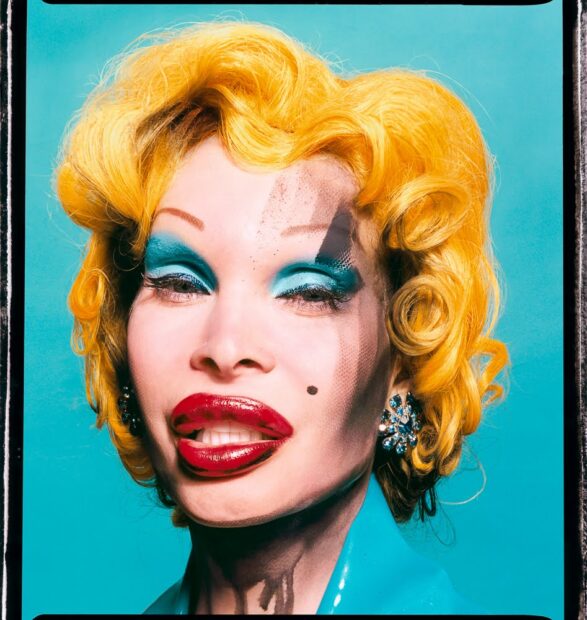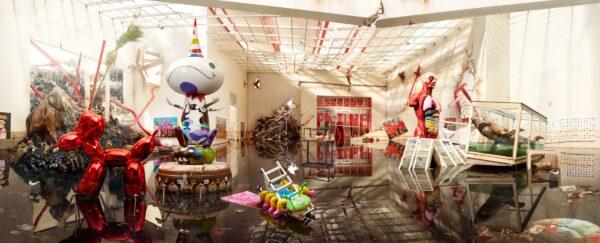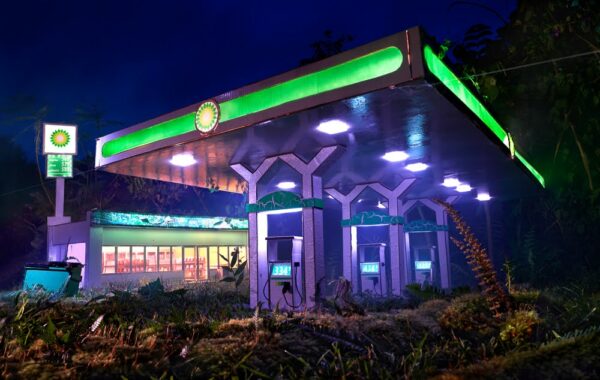
David LaChapelle, “My Own Marilyn,” (2002, New York), ©David LaChapelle, courtesy of Fotografiska New York
One look at My Own Marilyn, a photograph of Amanda Lepore made up to imitate Warhol’s iconic portrait of Marilyn Monroe, and the feeling of change becomes overwhelming. Lepore’s makeup and hair is electric and contrasts with her surgically modified visage, evoking idealism of the past as well as the outer boundaries of American identity. While taking the subway to and from Fotografiska’s opulent Park Avenue building in New York, I saw many promotional flyers for the exhibition emblazoned with My Own Marilyn. Nearly all of them had been vandalized, as subway posters often are.
Lepore, a longtime fixture of New York’s party culture, is a mainstay of David LaChapelle’s photography. She appears several times throughout Make Believe, the artist’s show at Fotografiska, on view through January 8, 2023. Many celebrities can be seen here, including Kanye West, Eminem, and Lana Del Rey. However, this photograph of Lepore is perhaps best suited to promote the exhibition and its presentation of spectacle. It properly encapsulates the experience of a LaChapelle photograph: the difficulty of separating fantasy from reality.
The sensation of seeing LaChapelle’s exhibition is one of awe: awe at his sizable oeuvre, awe at his ability to anticipate, diagnose, and satirize American themes of beauty and exceptionalism. Though he is known for his celebrity portraits, produced with eye-popping color and often for commercial clients, LaChapelle makes work that veers into more abstract and somber territory, a recurring theme that surfaced at the beginning of his career in 1984 and continues to the present day.
This is to say not all of the work is graphic like the magazine and album covers LaChapelle is known for. In his Awakened series, individuals hover, submerged in a pool of water; viewers’ perspective of the figures is at waist level. They seem slightly occupied, but also peaceful. It could be a metaphor for death, or being high. LaChapelle has posed each figure underwater in a way that exudes in-betweenness. These works sit in their own gallery, secluded from the bombastic portraits of his commercial work. They are one of many reminders in the exhibition of LaChapelle’s versatility.

David LaChapelle, “Aristocracy: Private Pirates” (2014, Los Angeles), ©David LaChapelle, courtesy of Fotografiska New York
Other series eschew the figure entirely. In Aristocracy: Private Pirates, LaChapelle positions private carrier jets amid competing plumes of smoke, colored as if a product of smoke bombs. The scene is clearly contrived — the jets are impossibly close to one another. Lachapelle has taken the status symbol of private travel and spun it into the world of surrealism. The plumes depicted in the work do not seem meteorological; they are not trying to be clouds. They instead appear as billowing dust and thinning haze. I was surprised by the dynamism of LaChapelle’s studio photography. He has the ability to make work that looks cataclysmic and somber at the same time.

David LaChapelle, “Seismic Shift,” (2012, Los Angeles), ©David LaChapelle, courtesy of Fotografiska New York
However, the chaotic style indicative of LaChappelle’s photography is still seen in this show. In Seismic Shift, we see a version of The Broad ravaged by an earthquake. Works by Jeff Koons, Damien Hirst, and other blue chip artists sit clustered in the gallery, surrounded by a layer of dirty water. Photographic moments like these display LaChapelle’s ability to diagnose and predict human anxieties about the cultural machine we have built for ourselves. When will the next crash come? How fragile are our institutions, both literally and figuratively?
Despite the intense chroma of LaChapelle’s work, seeing his images together doesn’t incite a feeling of giddiness. Instead, the show alludes to the fact that extremeness comes with an underlying cost. Sometimes, the work feels much more akin to that of Doug Aitken or Mitch Epstein than the loud, vibrant images I had come to expect from LaChapelle. There’s a lot to be seen here that examines existential dread rather than vanity. Celebrity portraits are often a valued snapshot of the past, meant to be enshrined forever. When there’s no commercial client involved, LaChapelle tends to instead photograph the future, or at least an imagined version of it rooted in collapse.
Fotografiska’s docents gave me plain directions: begin on the fifth floor and work your way down. This is standard procedure for many museums, including big ones like the Museum of Modern Art. While MoMA exhibits an amalgam of modern and contemporary art in its many forms and conventions, Fotografiska exclusively focuses on photography, and this is its sole exhibition at its New York location. Make Believe begins with a survey of LaChapelle’s more contemporary work, which has the paradoxical effect of inoculating the viewer to extremes: of fame, beauty, and scenes that demand meticulous positioning and, in some cases, editing.
The counter to this is the third floor, which revisits LaChapelle’s origins in photography in the late ‘80s. Painted directly onto film, these early works appear simpler, both in execution and in theme. The figures on this floor often resemble statues, painted bright blue or purple against yellow backgrounds. Flowers are also present throughout, and Christian iconography of saints and saviors frequently shows up in LaChapelle’s photography. The earliest work glows the most; seeing these photos feels foundational to understanding the strategies LaChapelle has used in his later portraits. The origins of his bright fashion photography, which employs convoluted scenes to display models and merchandise, is actually that of a diaristic artist who captures the world around him and vaults it into art.
Make Believe is a survey of one of the most prolific and recognizable living American photographers. The maximalism in LaChapelle’s work will be recognizable to all, but equally compelling is his penchant to delve into quieter, more pensive modes. It is a show to see if you are interested in a comprehensive overview of the photographs that have marked the past few decades of American culture.
David LaChapelle: Make Believe is on view at Fotografiska in New York City, through January 8, 2022
William Sarradet is the Assistant Editor for Glasstire.



